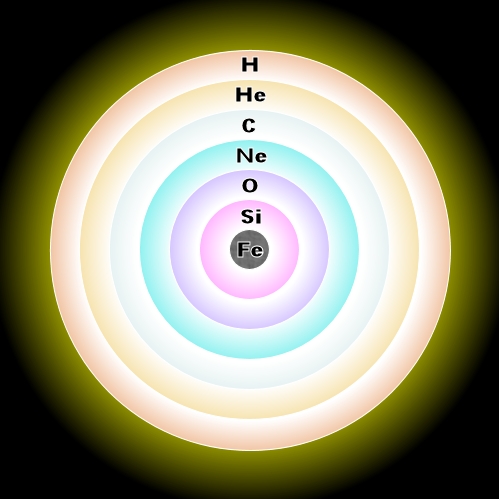10th Week: Supernovae and Nucleosynthesis B: Difference between revisions
| Line 27: | Line 27: | ||
==Type II== | ==Type II== | ||
[[Image:onion-like-core.jpg]] | |||
A type II supernova can occur if the mass of the star exceeds (roughly) 9 solar masses. Unlike type Ia, type II supernovae do not require accretion of matter from an external source. The progenitor of a type II supernova is a massive star that first consumes the hydrogen in its core by nuclear fusion generating mostly helium and leaving a hydrogen shell. When the pressure and temperature are high enough helium can start burning in the core generating several nuclides like carbon and oxygen. This process continues creating an onion-like structure of the progenitor (see Figure 1) with 56Fe in the core. At this point no nuclear fusion can generate more energy, thus there is not enough outward pressure that can keep the star from collapsing by its own weigh. | A type II supernova can occur if the mass of the star exceeds (roughly) 9 solar masses. Unlike type Ia, type II supernovae do not require accretion of matter from an external source. The progenitor of a type II supernova is a massive star that first consumes the hydrogen in its core by nuclear fusion generating mostly helium and leaving a hydrogen shell. When the pressure and temperature are high enough helium can start burning in the core generating several nuclides like carbon and oxygen. This process continues creating an onion-like structure of the progenitor (see Figure 1) with 56Fe in the core. At this point no nuclear fusion can generate more energy, thus there is not enough outward pressure that can keep the star from collapsing by its own weigh. | ||
Revision as of 09:54, 20 April 2009
Supernova
The final stage of the life of stars can be very different and depends strongly on the mass of the individual stars. Some star will just consume all their nuclear fuel and die quietly, but there are special cases in which the star ends its life with a violent explosion that can last for days. This process is called supernova.
Type Ia
Type 1a supernova, also called thermonuclear supernova, begins with a White Dwarf (WD) star with mass close to 1 solar mass. Very special conditions need to be satisfied in order for the WD to become a supernova. This is because the WD has to accrete matter, for example, if the WD is part of a binary system, the other star will be the source of matter for the WD. Other methods for the accretion of matter have been proposed but regardless of this, once the WD has reached Chandrasekhar limit (1.44 solar masses) the following reactions start taking place in the carbon-oxygen core of the WD
After this the following decays take place
All these reactions occur in a very short time, of the order of seconds. Thus an enormous amount of nuclear energy is released violently in the form of an explosion.
Type II
A type II supernova can occur if the mass of the star exceeds (roughly) 9 solar masses. Unlike type Ia, type II supernovae do not require accretion of matter from an external source. The progenitor of a type II supernova is a massive star that first consumes the hydrogen in its core by nuclear fusion generating mostly helium and leaving a hydrogen shell. When the pressure and temperature are high enough helium can start burning in the core generating several nuclides like carbon and oxygen. This process continues creating an onion-like structure of the progenitor (see Figure 1) with 56Fe in the core. At this point no nuclear fusion can generate more energy, thus there is not enough outward pressure that can keep the star from collapsing by its own weigh.





